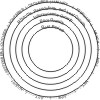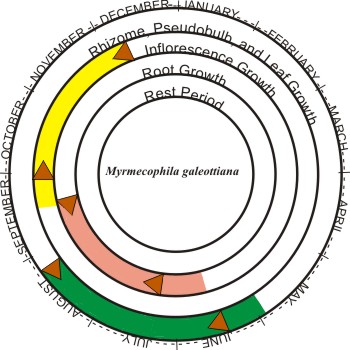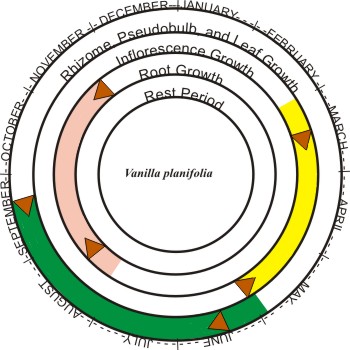
The Orchid Clock
Orchids, like other plants, have a cycle of life. The key to understanding the annual life cycle of a plant, and knowing how to respond to it, can be depicted visually as a clock.
(Click on the above for a full size image)
Orchid lovers and growers know that their plants will produce flowers at a certain time of year, and will grow new leaves and rhizomes at another time of year. By charting these times on a clock face, we can better respond to the needs of the plant in terms of fertilization, watering and other factors.
Every specie of orchid is different. Some orchids bloom in May and June, others bloom in time for the Christmas holidays. Some have blossoms that last for only a few days, while others last for months on end. Also, exact timing will depend on a number of factors, including the region of the world in which the plant is living.
This orchid clock should be duplicated for each specie that you have. Here's how to chart a time cycle chart for every specie in your collection. Begin by placing an arrow, pointing clockwise, at the time of year when a new inflorescence appears, and another arrow, pointing counterclockwise when the blooms fade. Place both arrows in the ring marked "inflorescence growth". Repeat this for the leaf growth ring and the root growth ring.
By seeing the times of the year when each of the significant growth patterns occur, we can now plan to fertilize our plants in a timely manner. To better visualize the fertilization patterns, I use three different colors of highlighter marker pens, green for growth, yellow for blooms, and pink for roots.
Start the highlighted area of the ring two to four weeks before the beginning and continue it to almost the end of the particular growth pattern, Note: there may be some overlap in ring colors.
Fertilizers are identified with three numbers, which I refer to as "Shoots," "Fruits" and "Roots." The first number is Nitrogen, an element needed for plant growth. The second number is Phosphate (P2O5), a chemical shown to increase flowering (and fruiting). The third is Potash (K2O), a chemical needed for root growth, overall plant health and stamina.
During the "green" time of year, I recommend a fertilizer that has a 20-10-10 rating. During the "yellow" time of year, you should consider a 10-20-10 fertilizer. The "pink" season calls for a 20-20-20 fertilizer. Any similar fertilizer ratings available to you should be sufficient.
The last ring, entitled Rest Period is when your plant needs to rest and muster its strength for the next year's growth. During "Rest Period, you should fertilize and water sparingly.
By looking at your orchid clock (and a calendar) you can now easily see what kind of fertilizer each specie of orchid in your collection needs.
The colors of the highlighter pens were chosen because they approximate the color of the fertilizer I use. Write the name of the orchid in the center of the clock. Whan completed, each clock can be laminated in plastic for protection.

